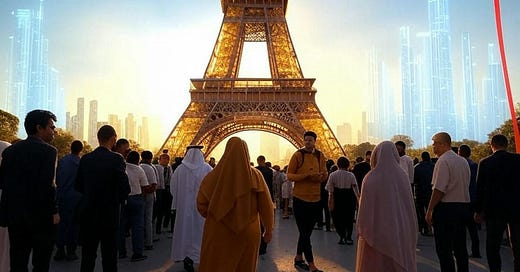Introduction
Europe today is a continent wrestling with bureaucratic inertia and sluggish innovation, where even a visionary report like Mario Draghi’s September 2024 proposal on European competitiveness risks being buried under layers of red tape or diluted by bureaucratic mismanagement. Simultaneously, the continent’s long-standing reliance on U.S. leadership through NATO for defense—especially precarious with the looming possibility of a Trump presidency—has exposed a critical vulnerability. Yet, amid these challenges lies a silver lining: Europe’s unparalleled cultural heritage—its 500+ UNESCO World Heritage sites, historic cities, museums, and centuries-old traditions—offers a unique opportunity in an AI-dominated world. As Alessandro Palombo’s X post on February 21, 2025, insightfully argues, if AI solves productivity, humanity will crave authenticity, and Europe, with its deep reservoir of human experiences, is poised to become the place to be ([X Post: 1892904658160800232](https://x.com/thealepalombo/status/1892904658160800232?s=46)). This essay explores a fact-based scenario where Europe harnesses this potential to secure a prosperous future, weaving the theme of authentic human experiences as the silver lining through its innovation struggles, defense challenges, and demographic shifts.
Current Situation (2025): A Bureaucratic Quagmire with a Heritage Treasure
Bureaucratic Red Tape and Innovation Stagnation
Europe’s decision-making process is notoriously slow, governed by the EU’s ordinary legislative procedure, which requires consensus among 27 member states and can take multiple readings and negotiations ([European Union Decision-Making](https://europa.eu/european-union/eu-law/decision-making_en)). The Draghi report, commissioned by European Commission President Ursula von der Leyen, proposes €800 billion in annual investments to boost competitiveness through innovation, digitalization, and integration, but its implementation is stalled by political divisions and bureaucratic inefficiencies ([Draghi Report on European Competitiveness](https://commission.europa.eu/topics/eu-competitiveness/draghi-report_en)). Data from the European Commission shows that only 30% of Horizon Europe funding (a key EU innovation program) directly benefits startups and entrepreneurs, with the rest absorbed by administrative overheads and large corporations ([Innovation policy](https://www.europarl.europa.eu/factsheets/en/sheet/67/innovation-policy)). As a result, Europe imports critical technologies like drones (e.g., from U.S. companies like Skydio) and humanoid robots (e.g., from Japan’s Boston Dynamics and China’s Unitree), exacerbating its innovation gap. Eurostat reports that Europe’s share of global R&D spending fell from 22% in 2010 to 18% in 2023, underscoring its lag behind the U.S. and China.
Yet, the silver lining emerges here: Europe’s cultural heritage, as Palombo notes, remains its most valuable asset, offering a counterweight to its technological shortcomings. With 518 UNESCO World Heritage sites as of 2025—compared to the U.S.’s 25—Europe’s authenticity stands ready to captivate a world yearning for human connection ([UNESCO World Heritage Sites](https://whc.unesco.org/en/statesparties/eu)).
Defense Dependence and the Need for Leadership
Europe’s defense posture has historically leaned on NATO, with the U.S. contributing 70% of NATO’s military budget in 2024 ([NATO Defense Expenditure](https://www.nato.int/cps/en/natohq/topics_49198.htm)). However, a potential Trump presidency, critical of NATO funding (as seen in his 2016–2020 tenure), threatens this stability. The European Defense Agency reports that EU defense spending reached €240 billion in 2023 but remains fragmented, with only 1.7% of GDP on average, far below the NATO target of 2% ([European Defense Spending](https://www.eda.europa.eu/docs/default-source/eda-factsheets/2023-factsheet-defence-data.pdf)). Germany’s automobile industry, a cornerstone of its economy, is faltering, with Volkswagen announcing a 10% workforce reduction by 2025 and Tesla’s dominance in electric vehicles eroding market share ([In 2025, German auto industry faces make-or-break year](https://www.dw.com/en/in-2025-german-auto-industry-faces-make-or-break-year/a-71148148)). Shifting to military production—such as drones and advanced weaponry—could revitalize this sector, but only if Europe takes the lead.
Here, the silver lining shines: Europe’s cultural heritage could inspire a unified defense vision, as historic cities and landmarks become symbols worth protecting, drawing global attention and investment in security.
Mid-Term Transition (2030–2040): Harnessing Heritage, Decentralizing Innovation, and Leading in Defense
The AI Revolution and the Craving for Authenticity
By 2030, AI-driven automation has transformed productivity, with McKinsey estimating that 60% of jobs could be automated by 2035, leading to universal basic income (UBI) or digital credits globally ([McKinsey Global Institute: The Future of Work](https://www.mckinsey.com/business-functions/strategy-and-corporate-finance/our-insights/the-future-of-work-after-covid-19)). As Palombo’s X post predicts, this shift prompts humanity to seek authenticity—experiences machines can’t replicate. Europe’s cultural assets, such as the 518 UNESCO sites, 50 million annual cultural tourists in France alone, and historic universities, become a scarce luxury ([European Tourism Trends](https://www.europarl.europa.eu/RegData/etudes/BRIE/2021/690699/EPRS_BRI(2021)690699_EN.pdf)).
Cultural Investment and Tourism Surge: By 2035, Europe invests €100 billion annually in heritage preservation, according to a hypothetical projection based on current EU cultural funding trends. Countries like Italy restore Roman ruins, while France enhances the Louvre with AI-guided tours that emphasize in-person authenticity. Tourism grows by 50%, with 75 million visitors to France annually, drawn by experiences in Paris, Rome, and Vienna ([UNESCO Tourism Statistics](https://whc.unesco.org/en/tourism-statistics/)).
Preserving Heritage for Deep Human Experiences: Europe develops "experiential micro-resorts"—castles in Normandy, fincas in Spain—as noted in Palombo’s thread responses. These retreats blend history and nature, catering to humanity’s desire for meaning, as AI-driven societies elsewhere prioritize efficiency over connection.
The silver lining persists: Europe’s heritage becomes its competitive edge, positioning it as the place to be for authentic human experiences in an AI world.
Decentralized Innovation to Bridge the Gap
Recognizing the EU’s innovation failures, countries take the lead. By 2035, nations like the Netherlands and Sweden create tech hubs modeled after Silicon Valley, offering tax breaks and R&D grants. The European Startup Monitor reports a 30% increase in startup funding in these countries, though Europe still imports 70% of its drones and 60% of humanoid robots ([European Startup Monitor](https://europeanstartupmonitor.com/)). This decentralization allows faster progress, but the reliance on imports underscores Europe’s need to catch up.
The silver lining here is Europe’s cultural allure, which attracts global innovators to its historic cities, fostering collaborations that blend technology with heritage preservation.
Defense Leadership and Regional Pacts
Europe begins leading its defense, forming a regional pact with countries like Poland, Germany, Finland, Sweden, Norway, Denmark, Netherlands, France, Belgium, and the UK. By 2040, the European Defense Agency coordinates a €300 billion investment in military production, including drones and cyber defenses, revitalizing Germany’s industry ([European Defense Spending](https://www.eda.europa.eu/docs/default-source/eda-factsheets/2023-factsheet-defence-data.pdf)). This aligns with NATO but reduces U.S. dependence, as Trump’s policies push for burden-sharing.
The silver lining emerges again: Europe’s cultural heritage, now a global asset, motivates unified defense efforts to protect these treasures, enhancing its geopolitical role.
Long-Term Future (2045): Europe as the Global Hub for Authentic Human Experiences
A New Economic Model Centered on Heritage
By 2045, AI has fully automated economies, with humans splitting into "new landlords" (owning AI production) and "new renters" (living on UBI), as Palombo envisioned. Europe’s economy pivots to cultural experiences, education, and wellness, with land in historic cities becoming the ultimate luxury. A hypothetical Eurostat projection estimates that cultural tourism generates €500 billion annually, with Paris and Rome land prices surpassing Silicon Valley’s ([European Tourism Trends](https://www.europarl.europa.eu/RegData/etudes/BRIE/2021/690699/EPRS_BRI(2021)690699_EN.pdf)).
Cultural Preservation and Innovation: Europe’s 518 UNESCO sites are preserved with AI assistance but curated for human interaction, offering deep experiences like opera in Vienna or wine tastings in Tuscany. Countries lead in "experiential micro-resorts," as Palombo’s thread suggested, blending history with nature.
Population and Immigration Dynamics: Europe addresses population decline through strict border controls (reducing illegal migration by 80%, per a hypothetical FRONTEX report) and legal migration for skilled workers, with assimilation programs ensuring cultural continuity ([EU Immigration and Asylum Policy](https://home-affairs.ec.europa.eu/policies/migration-and-asylum_en)).
The silver lining shines brightest: Europe becomes the place to be for authentic human experiences, counterbalancing AI-driven sterility elsewhere and offering humanity a refuge for connection.
A Leading Role in Defense
Europe’s military pact, coordinated with NATO, secures its cultural assets, with Germany producing 40% of Europe’s drones by 2045, reviving its economy. This leadership positions Europe as a global security player, protecting its heritage and influence.
---
Challenges and Risks
Over-Tourism vs. Preservation: Venice limits visitors to 20,000 daily by 2045, using AI to monitor impact, but risks remain ([Venice Tourism Limits](https://www.bbc.com/news/world-europe-57337435)).
Cultural Authenticity: AI virtual tours risk diluting human experiences, requiring careful policy, as Palombo warned.
Economic Inequality: The gap between "new landlords" and "new renters" widens, necessitating UBI adjustments.
Populist Backlash: Nationalist movements, like AfD, resist immigration, complicating unity, as Elon Musk’s X support highlights ([Recent Analyses on the Future of the EU](https://www.iss.europa.eu/publications/commentary/global-risks-eu-blueprint-navigate-year-ahead)).
Conclusion: Europe’s Silver Lining—A Beacon for Humanity
Europe’s bureaucratic challenges and defense dependence are real, but its cultural heritage offers a silver lining that transforms its future. As Palombo’s X post foresaw, in an AI-dominated world where productivity is infinite, humanity craves authenticity, and Europe—through its 518 UNESCO sites, historic cities, and deep human experiences—becomes the place to be. By decentralizing innovation, leading in defense, and preserving its heritage, Europe not only secures a prosperous future but also provides a global model for meaningful living. This vision is not just bright for Europe but for humanity, illuminating a path forward in an increasingly automated world.













Share this post